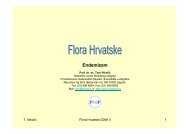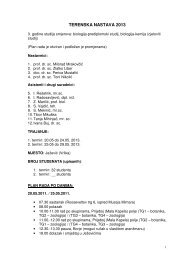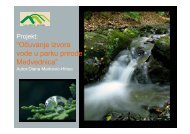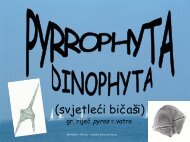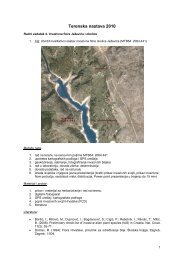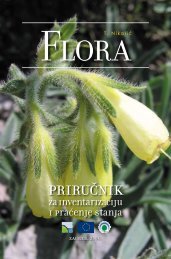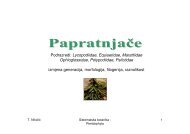important plant areas in central and eastern europe - hirc.botanic.hr ...
important plant areas in central and eastern europe - hirc.botanic.hr ...
important plant areas in central and eastern europe - hirc.botanic.hr ...
Create successful ePaper yourself
Turn your PDF publications into a flip-book with our unique Google optimized e-Paper software.
Section 5Recommendations■ Further development of the nationalIPA network, as <strong>in</strong>formation on new sitesbecomes available (80-100 more sites areexpected to be added).■ More extensive <strong>in</strong>clusion of spore<strong>plant</strong>s <strong>and</strong> fungi <strong>in</strong>to the network.■ Larger scale application of Criterion B<strong>in</strong> identification of future sites.The quality of data <strong>and</strong> especially the long-term trend <strong>in</strong>formation varies considerablyfrom site to site.The best <strong>in</strong>formation comes from sites that have been extensivelystudied by the scientific community, such as national parks <strong>and</strong> a few nature reserves, orthose sites with rare or <strong>in</strong>terest<strong>in</strong>g species. However, s<strong>in</strong>ce the <strong>in</strong>troduction of severalmonitor<strong>in</strong>g schemes such as Ramsar, NATURA 2000, <strong>and</strong> red list projects, data flow hasnotably <strong>in</strong>creased <strong>and</strong> the IPA programme will also be able to contribute to improv<strong>in</strong>gtrend assessments <strong>and</strong> monitor<strong>in</strong>g possibilities.Key t<strong>hr</strong>eats to IPAs <strong>in</strong> Pol<strong>and</strong>■ Establish<strong>in</strong>g a monitor<strong>in</strong>g programmefor IPAs already identified.■ “Lobby<strong>in</strong>g” for <strong>in</strong>clusion of IPAs thatare not otherwise protected <strong>in</strong>to someformal network of protected <strong>areas</strong>; iffeasible, also promotion of <strong>in</strong>creasedprotection for sites with low levels ofprotection.No. ofIPAs■ Actions towards secur<strong>in</strong>g permanentf<strong>in</strong>ancial support from the M<strong>in</strong>istry ofEnvironment (or other sources), toguarantee the existence <strong>and</strong> developmentof the national IPA network.■ Integration of the nationally identifiedIPAs <strong>in</strong>to pan-European networks ofprotected <strong>areas</strong>.Tourist <strong>and</strong> recreation development is the s<strong>in</strong>gle most widespread t<strong>hr</strong>eat to IPAs <strong>in</strong>Pol<strong>and</strong> (68 IPAs). Inappropriate forestry practices affect 56% of IPAs (<strong>in</strong>tensifiedforest management (IFM) 53, deforestation 27, afforestation 25). Infrastructure <strong>and</strong>transport development is also one of the most significant t<strong>hr</strong>eats (56 IPAs), as well asurban development (45 IPAs) <strong>and</strong> <strong>in</strong>dustrial development (38 IPAs). Inappropriatewater management systems, <strong>in</strong>clud<strong>in</strong>g dra<strong>in</strong>age, extraction, <strong>and</strong> canalisation, affect 49IPAs, <strong>and</strong> eutrophication affects 28 IPAs. Burn<strong>in</strong>g of vegetation <strong>and</strong> aquaculture <strong>and</strong>fisheries also t<strong>hr</strong>eaten IPAs <strong>in</strong> Pol<strong>and</strong>.50






